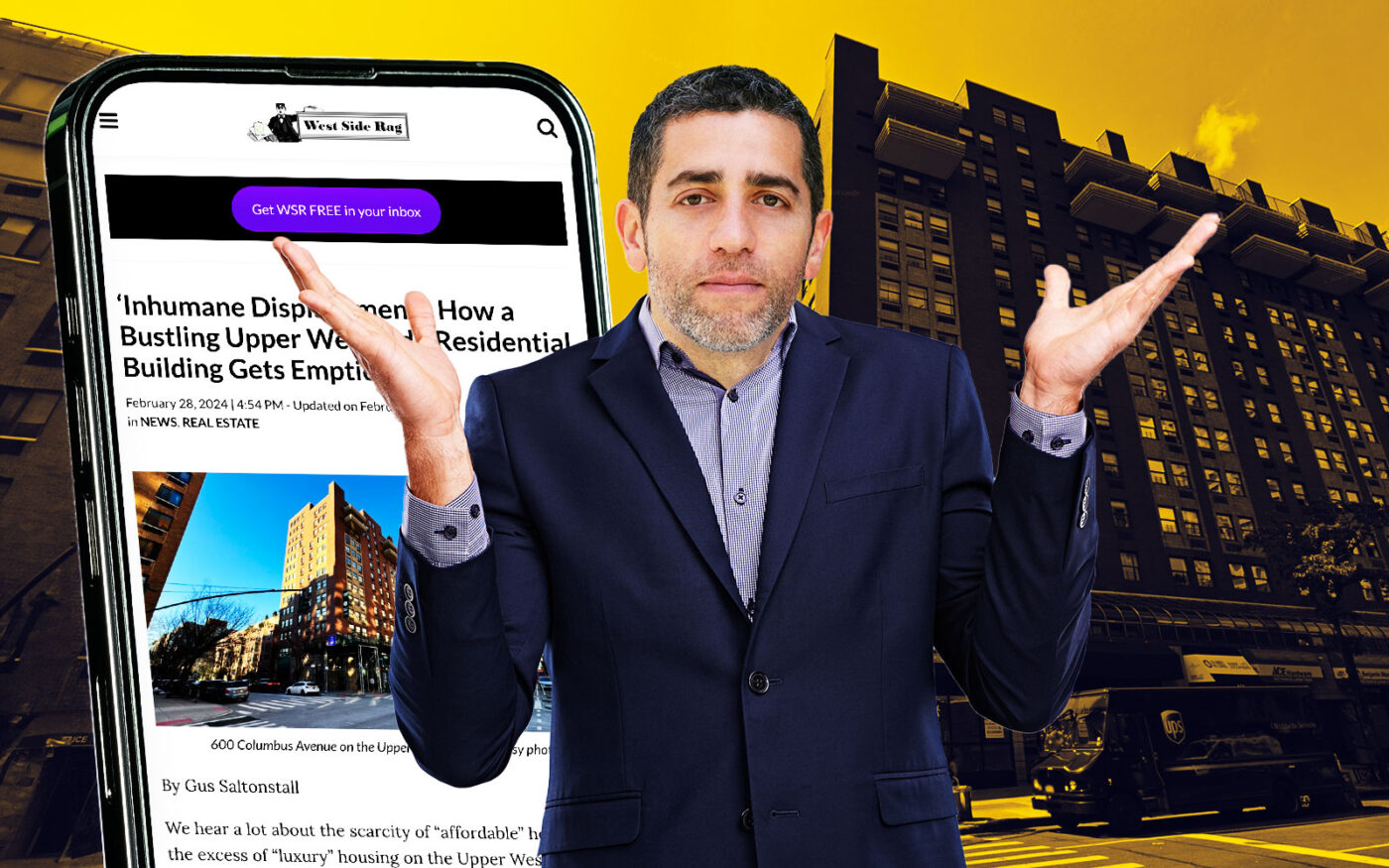Developers need a lender, a lawyer, an architect, a contractor and — for certain projects — a crisis management firm.
Case in point: Slate Property Group’s 600 Columbus Avenue.
In a standard value-add play, Slate bought it last year for $120 million and set about upgrading the 166-unit building and raising rents. For quite a few New Yorkers, this basic real estate strategy is greedy if not “predatory.”
Media coverage is a risk. Slate’s action was written up by the West Side Rag, which couldn’t resist putting one tenant’s complaint of “inhumane displacement” in its headline. To be fair, neither could The Real Deal. If it bleeds, it leads.
Readers were drawn to the West Side Rag story, posting 117 comments that perfectly captured the never-ending debate about profit and morality in New York real estate.
But first, the facts. Some tenants told the Rag they were being hit with 60 percent rent increases. Slate says the average market-rate increase in the past year has been 8.6 percent. Who’s telling the truth?
Tenants may have seen two-bedroom units like theirs listed for $8,000 and assumed their $5,000 rents would be jacked up to that number. That is indeed 60 percent, but an assumption is not a fact. Maybe only new tenants are asked to pay that. StreetEasy lists only one unit as available.
Slate says it is trying to retain tenants and that 76 percent of those with expiring market-rate leases renewed. On the other hand, a 24 percent non-renewal rate is higher than would be caused by 8.6 percent rent hikes.
Some folks were clearly asked to pay more and balked, or just chose to move permanently rather than relocate temporarily while Slate renovated their apartments.
Is that fair? Rag readers disagreed.
“We were not PRICED out, we were FORCED out,” one tenant, Emma, commented below the article. “We were not given an option to stay except ‘to move out for two months at our expense’ while a cosmetic and unnecessary renovation was taking place.”
Slate’s 8.6 percent figure is for past renewals, not future ones. Increases will likely be higher because it’s adding a gym, upgraded common areas and other amenities that people aspiring to live on the Upper West Side typically expect and can afford.
Some Rag readers sympathized with tenants like Emma, but a surprising number sided with the landlord.
“Sam” started the exchange by complaining that elected officials, especially Manhattan Borough President Mark Levine, “keep saying that more affordable housing is needed — but conveniently ignore all the housing that is lost or at risk such as in this case.”
“UWS Dad” replied: “Mark Levine is very clear & correct on the only way to solve this — build more housing so that landlords are not able to push through rent increases like this. We’ve under-built housing in NYC for decades and now rent prices are hitting all-time highs.”
Experts agree. But some New Yorkers believe their housing market is unique and defies the laws of economics.
Perception and reality
“Tons of residential buildings going up — all luxury high-rises,” someone named Evi wrote. “The city and elected officials enabled use of land for unfettered luxury development. It is disingenuous for Mark L etc to keep saying more affordable housing is needed when they’ve allowed the current situation.”
“So true,” a reader named Pedestrian chimed in.
Actually, not true. Not all residential buildings going up are luxury high-rises.
Lots of projects are using the old 421a tax abatement for mixed-income rentals, including large ones in rezoned Gowanus and Inwood.
Meanwhile, huge affordable housing projects (and many smaller ones) are rising in East New York, Central Brooklyn, northern Manhattan and the South Bronx. An affordable development in Queens is the city’s largest in 40 years.
Heck, 600 Columbus itself has an affordable component — 20 percent of units are for Section 8 renters, under a government program tapped by the building’s developer in 1985.
While affordable projects are launched regularly, market-rate filings have all but dried up.
New Yorkers don’t see the press releases or the filings detailing these projects. Evi and Pedestrian are surely Upper West Siders who perceive the world myopically, like this. But I digress.
UWS Dad sent them a polite rebuttal. “New buildings are certainly expensive but what they do is absorb the demand from people who can afford them and make it so that older buildings like the one in this article have less to gain from evicting existing tenants,” he wrote.
“Are you looking for a job with REBNY or the Adams administration?” Pedestrian shot back. “Trickle down doesn’t work in the economy or housing!”
UWS Dad expertly disarmed Pedestrian, saying, “This isn’t ‘trickle down,’ this is basic supply and demand. Don’t care for Adams, I am just so tired of watching dear friends decide to move away because they can’t stomach paying these absurd rents.”
The civility did not last.
Trickle-downs and trade-offs
No New York housing discussion would be complete without the “not everyone gets a pony” argument. Enter Boris.
“Why does the affordable housing have to be on the expensive UWS?” he wrote. “People who can’t afford market rates in the geographical area they prefer have to compromise and take what they can afford in another area. That’s life.”
Christine E added, “I know plenty of people who moved from UWS to other neighborhoods in NYC for lower rent and/or more space, or who stayed and accept the trade-off of a smaller apartment in order to be in more expensive neighborhoods like UWS,” she wrote.
“They don’t deny the reality of economics or expect government legislation or media coverage or public outrage to save them. And frankly that is how neighborhoods outside of UWS grow.”
Pedestrian dismissed Christine as “another trickle-down crusader.” Full disclosure: My own parents, looking to start a family, left their Upper West Side rental in 1967 to buy a historic Park Slope limestone for $36,000. Trickle-down worked out for them.
The concept of trade-offs is crucial in economics, and other readers brought it up, noting that renters have less responsibility and more flexibility than homeowners.
“I sympathize with the tenants who are getting priced out of their apartments. But this is nothing new and nothing unexpected,” wrote David S. “Anyone who rents a market-rent apartment in New York City does so knowing that they’re at the mercy of the landlord, and should go in with the assumption that something like this will happen at some point.”
The comments delved into all the other hot-button housing issues. Should landlords charge what the market will bear? Is good cause eviction the answer?
Some readers reported having landlords who barely raised rents. Others said that’s a calculation about keeping good tenants, not a matter of kindness.
“It’s possible to care more about your tenants than your profit. It’s a moral choice,” wrote Adrienne.
“I call BS on all of that,” Peter answered. “It’s never a purely moral choice. It’s a financial choice, masquerading as such, while actually taking other variables into account … The risk associated with an unknown new tenant, the time to re-list and without having a tenant in place, the current market strength in the area, etc.”
Other capitalists weighed in.
“Like it or not, the property belongs to the owner of the building, not the renters,” wrote Otis. “The landlord is not running a philanthropy. The landlord’s obligation is to maximize its profits and it is not under obligation to provide apartments in perpetuity at the same rent if it feels the market can generate higher rents. It seems to me the landlord is acting legally, rationally and morally.”
“They are acting ‘morally?’ Whose morals would that be, exactly? Yours?” replied JC. “And what sort of people are the 34 who upvoted this post?”
Before long, 62 readers had upvoted Otis’ post. But others were outraged by it.
“The landlord has no obligation to maximize profits. What a ridiculous thing to say,” wrote Laura. “It’s a choice to evict people and push rents much higher, and it’s not a moral one.”
We will give the last word to UWS Dad, who offered a reality check.
“There is no legal duty on a corporation or any other entity to ‘maximize’ their profits. But, let’s be real. These corporations and entities that purchase real estate usually have investors and those investors want the highest return on their investments and, if the investors don’t get the ‘highest’ return, they won’t invest in that corporation again and will invest their money with some other corporation that will.”
Read more



